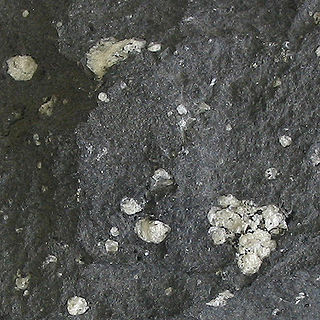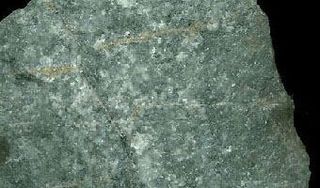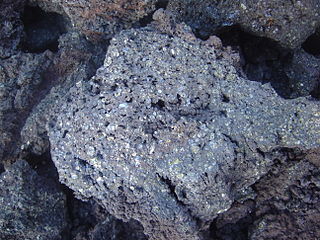 W
WAlkali basalt or alkali olivine basalt is a dark-colored, porphyritic volcanic rock usually found in oceanic and continental areas associated with volcanic activity, such as oceanic islands, continental rifts and volcanic fields. Alkali basalt is characterized by relatively high alkali (Na2O and K2O) content relative to other basalts and by the presence of olivine and titanium-rich augite in its groundmass and phenocrysts, and nepheline in its CIPW norm.
 W
WAndesite is an extrusive volcanic rock of intermediate composition. In a general sense, it is the intermediate type between basalt and rhyolite. It is fine-grained (aphanitic) to porphyritic in texture, and is composed predominantly of sodium-rich plagioclase plus pyroxene or hornblende.
 W
WAphanite, or aphanitic as an adjective, is a name given to certain igneous rocks that are so fine-grained that their component mineral crystals are not detectable by the unaided eye. This geological texture results from rapid cooling in volcanic or hypabyssal environments. As a rule, the texture of these rocks is not the same as that of volcanic glass, with volcanic glass being non-crystalline (amorphous), and having a glass-like appearance.
 W
WBasanite is an igneous, volcanic (extrusive) rock with aphanitic to porphyritic texture. It is composed mostly of feldspathoids, pyroxenes, olivine, and plagioclase and forms from magma low in silica and enriched in alkali metal oxides that solidifies rapidly close to the Earth's surface.
 W
WDacite is an volcanic rock formed by rapid solidification of lava that is high in silica and low in alkali metal oxides. It has a fine-grained (aphanitic) to porphyritic texture and is intermediate in composition between andesite and rhyolite. It is composed predominantly of plagioclase feldspar and quartz.
 W
WDiabase or dolerite or microgabbro is a mafic, holocrystalline, subvolcanic rock equivalent to volcanic basalt or plutonic gabbro. Diabase dikes and sills are typically shallow intrusive bodies and often exhibit fine grained to aphanitic chilled margins which may contain tachylite. Diabase is the preferred name in North America, while dolerite is the preferred name in the rest of English-speaking world, where sometimes the name diabase is applied to altered dolerites and basalts. Some geologists prefer the name microgabbro to avoid this confusion.
 W
WMugearite is a type of oligoclase-bearing basalt, comprising olivine, apatite, and opaque oxides. The main feldspar in mugearite is oligoclase.
 W
WPicrite basalt or picrobasalt is a variety of high-magnesium olivine basalt that is very rich in the mineral olivine. It is dark with yellow-green olivine phenocrysts (20-50%) and black to dark brown pyroxene, mostly augite.
 W
WRhyodacite is a volcanic rock intermediate in composition between dacite and rhyolite. It is the extrusive equivalent of those plutonic rocks that are intermediate in composition between monzogranite and granodiorite. Rhyodacites form from rapid cooling of lava relatively rich in silica and low in alkali metal oxides.
 W
WRhyolite is the most silica-rich of volcanic rocks. It is generally glassy or fine-grained (aphanitic) in texture, but may be porphyritic, containing larger mineral crystals (phenocrysts) in an otherwise fine-grained rock. The mineral assemblage is predominantly quartz, sanidine and plagioclase. It is the extrusive equivalent to granite.